One of the most important factors in the development of a strong continuous improvement and containment plan is the quality-related data you capture. It’s difficult to make significant changes without the granular insights needed to evaluate equipment, frontline employees, and policy impact in the organization.

Fortunately, technology makes it easier than ever to capture and leverage this kind of data to make improvements. From IIoT sensors and devices that integrate seamlessly with existing systems to cloud-based software applications that capture valuable data from your workers and enable stronger communications across the organization. Let’s take a closer look at what it takes to capture quality-related data and how to start leveraging it for long-term improvements.
IIoT Sensors and Devices for Data Capture
The Internet of Things market has exploded in recent years, and is expected to surpass $1 trillion by 2026 according to Fortune Business Insights and there will be more than 25 billion IoT devices by 2021 according to Gartner. For manufacturing in particular, the Industrial Internet of Things (IIoT) represents a cornerstone in the implementation of Industry 4.0 initiatives. Growth is already booming, and that’s with major initiatives like 5G still years away from commercial availability.
Suffice it to say, there is a major increase in access to smarter systems - both in hardware and software - to measure and analyze frontline operations in a manufacturing plant. Some of the most important include:
- Inspection Technology - Standardized workstations equipped with cutting edge technology such as a vision system, tablet interface, and camera help ensure consistent process deployment and data capture. Custom reporting and vehicle repair tracking software similarly help to capture vital data in the inspection process.
- Barcode Scanners - Barcode scanners eliminate the risk of incorrect keying and rekeying of part numbers, as well as improved tracking of parts within and outside the plant, and better inventory management.
- Metal and X-Ray Inspection Systems - Inspection systems that can detect foreign substances, address potential quality issues automatically and adapt based on individual part needs offer an important stopgap against common quality issues on the frontline.
- Machine Vision Systems - Machine vision systems utilize smart cameras, AI-driven software, and sensors to integrate with existing hardware to identify anomalies and other issues before they can impact the production line.
- Checkweighers - Combined with metal detectors, X-rays and other sensors, Checkweighers help ensure accuracy for each part that crosses the production line. They can also be outfitted to capture data about each part that is measured for future analysis.
The right combination of these systems allows companies to capture measurable, quantitative data about performance, quality, and safety.
Connected Worker Tools for Training and Evaluation
Technology is an important tool in attracting, training, and retaining employees on your front line. With an expected $2.5 trillion impact by 2028 of the persistent manufacturing skills shortage, companies need to integrate new tools and systems that help improve training performance. At the same time, shortages can lead to less skilled employees being thrust into high-value positions. That inexperience can have a direct and lasting impact on quality.
Connected worker tools are designed to address these issues. They include resources such as:
- Digital Andon Cord - By connecting every individual in an organization, frontline workers gain access to the collected knowledge of the entire company, not just their trainer. Hidden factory processes are reduced, and quality issues are both identified and communicated to key stakeholders faster.
- Standard Work Improvement - Employees are provided with consistent training tools in the format that best fits their approach to learning. Instead of length classroom-based learning that can have retention rates as low as 10%, employees engage with microlearning modules that include key information they need for individual tasks at the point of need. This boosts retention and improves overall quality.
- Mobile Access - Increasing, connected worker tools are designed to work with existing smartphone and tablet technology. This reduces the upfront cost to implement and allows employees to instantly engage with one another via the new platform.
Digital Checklists to Capture Process
Digital checklists allow employees to quickly engage with vital information related to their workstation on an as-needed basis. Instructions can be updated centrally to ensure consistency throughout the organization, and can be integrated with IIoT sensor data to evaluate checklist performance and identify areas for improvement. Instead of paper-based checklists and work instructions that can quickly become outdated, a digital-first approach ensures everyone - even in a massive organization - is on the same page at all times.
Centralized Systems for Organizing and Analyzing Data
By centralizing key systems and capturing data in as many places as possible in your organization, you can greatly increase the performance of your frontline and ensure a higher level of quality across the board.
Learn more about how PTI QCS is implementing Industry 4.0 technology to improve performance, reduce the risk of quality issues, and provide key insights to our clients as part of ongoing containment and continuous improvement efforts.



